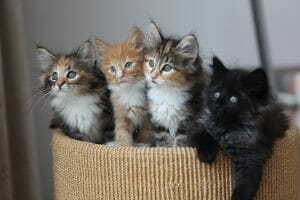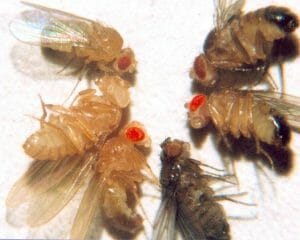Multiple Alleles Definition
Multiple alleles exist in a population when there are many variations of a gene present. In organisms with two copies of every gene, also known as diploid organisms, each organism has the ability to express two alleles at the same time. They can be the same allele, which is called a homozygous genotype. Alternatively, the genotype can consist of alleles of different types, known as a heterozygous genotype. Haploid organisms and cells only have one copy of a gene, but the population can still have many alleles.
In both haploid and diploid organisms, new alleles are created by spontaneous mutations. These mutations can arise in a variety of ways, but the effect is a different sequence of nucleic acid bases in the DNA. The genetic code is “read” as a series of codons or triplets of nucleic acid bases that correspond to individual amino acids. A mutation causes the sequence of amino acids to change, either in a simple or drastic way. Simple changes that only affect a few amino acids can produce multiple alleles in a population, all of which function in almost the same way, just to a different degree. Other mutations cause large changes in the protein created, and it will not function at all. Other mutations give rise to novel forms of protein which may allow organisms to develop new pathways, structure, and functions.
Most of the time, scientists focus on the phenotypes that are created by certain alleles, and all alleles are classified by the phenotypes they create. However, a given phenotype can be caused by a large number of mutations. While humans have thousands of genes, they have over 3 billion base pairs. This means each gene consists of many, many base pairs. A mutation in any base pair can cause a new allele.
Multiple alleles combine in different ways in a population, and produce different phenotypes. These phenotypes are caused by the proteins encoded for by the various alleles. Although each gene encodes for the same type of protein, the different alleles can cause high variability in the functioning of these proteins. Just because a protein functions at a higher or lower rate does not make it good or bad. This is determined by the sum of the interactions of all the proteins produced in an organism and the effects of the environment on those proteins. Some organism, driven by multiple alleles in a variety of genes, do better than others and can reproduce more. This is the basis of natural selection, and as new mutations arise and new lines of genetics are born the origin of species takes place.
Examples of Multiple Alleles
Coat Color in Cats
In domestic cats, breeding has taken place for thousands of years selecting for different and varied coat colors. Cats can be seen with long hair, short hair, and no hair. There are genes that code for whether or not a cat will have hair. There are multiple alleles for this gene, some that produce hairless cats, and some that produce cats with hair. Another gene regulates the length of the hair. Long haired cats have two recessive alleles, while a dominate allele will produce short hair.
Other genes control the color of coat. There is a gene for several colors of pigment: red, black and brown. Each gene has multiple alleles in the population, which express the protein responsible for making the pigment. Each allele changes the way the protein works, and therefore the expression of the pigment in the cat. Other genes, in similar ways, control traits for curliness, shading, patterns, and even texture. The amount of combinations and expressions of different genotypes together creates an almost infinite variety of cates. For this reason, cat breeders have been successfully attempting for thousands of years to create new and strange varieties of cats, and dogs for that matter. Even with only 4 alleles between two parents at each gene, the variety can be incredible. Just look at the kittens in the photo above. All these kittens came from the same parents.
Fruit Flies
In the year 2000, scientist finally succeeded in mapping the complex genome of the common fruit fly, Drosophilia melanogaster. The fruit fly had been, and continues to be, a valuable laboratory animal because of its high reproduction rate and the simplicity of keeping and analyzing large quantities of flies. At about 165 million base pairs, the DNA of a fruit fly is much smaller than that of a human. While a human has 23 chromosomes, a fruit fly only has 4. Still, in only 4 chromosomes, there exists around 17,000 genes. Each gene controls a different aspect of the fly, and is subject to mutation and new alleles arising.
In the picture above, all the flies are the same species Drosophilia melanogaster. The variation seen between the flies is caused by multiple alleles, in different genes. For instance, the gene for eye color determines if the fly will have an orange/brown eye, a red eye, or a white eye. Both the white and orange alleles are recessive to the wild type red eye allele. The two flies at the top have wild type bodies, a tan with dark stripes. In the gene that controls body color, two other alleles are present. The fly on the far right is showing a homozygous recessive genotype that causes a dark body. The three flies on the bottom show another homozygous recessive genotype, the yellow body mutation.
Other traits include everything from how the wings form, to the shape of the antennae, to the enzymes produced in the fly’s saliva. Although 17,000 genes may not seem like that many, the total number of alleles in a population makes the total variety much higher than that. Each newly mutated allele adds another combination to the almost infinite pool of genetic variety.
Related Biology Terms
- Homozygous – An individual with two of the same allele, as opposed to heterozygous individuals which have two different alleles.
- Mutation – The replacement of a nucleic acid base in a gene with another nucleic acid, multiple nucleic acids, or the deletion of the nucleic acid altogether.
- Epistasis – When multiple genes produce an effect on the same trait, a fact true of most traits even if it is hard to see.
Quiz
1. A mutation arises in a gene that causes a very minor change in the protein produced. The changes are so minor that the protein functions in practically the same way. So, although a new allele was produced, it is not that much different from the wild-type, or most common allele. Will this allele persist in the population?
A. Yes
B. No
C. Maybe
2. In some genes with multiple alleles, when the alleles are together in a genotype they express their influence equally in the phenotype. This is known as incomplete dominance. However, other alleles in the population may not express themselves equally, and are considered recessive. If an organism with two dominant alleles and an incompletely dominant phenotype breeds with an organism with two recessive alleles, what will the offspring look like?
A. They will look like one or the other dominant alleles.
B. They will be something in between the two parents.
C. They will also show incomplete dominance.
3. Often, breeders of animals aim to breed “true” lines. This means that generation after generation, the animals will look almost exactly the same, and the number of different alleles in a population is reduced. Why would this be important for scientific research?
A. It is not important.
B. Stable organisms ensure that the experiment can be repeated.
C. More variety is good for research.


